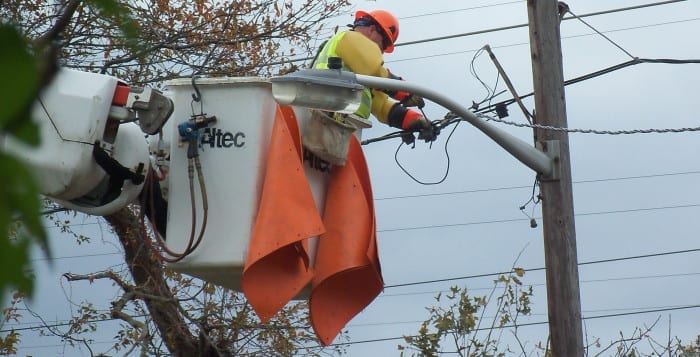Village wants emergency backup energy grid
With several emergency services packed into a small area, Port Jefferson Village officials hope to secure a grant from the New York State Energy Research and Development Authority toward building a local backup energy grid to be used in case of a crisis.
The village applied for the NYSERDA grant to build the backup grid, known as a microgrid, through a statewide competition because of the critical community services that cannot stop functioning during a power outage, Mayor Margot Garant said.
“During a severe weather event such as we had with [hurricanes] Irene and Sandy, where the hospitals lost power and some of us lost power — some up to 14 days, [and the] hospitals were out eight to 10 days — those … patients that were on critical care services were put in harm’s way,” Garant said at the village board of trustees meeting Monday night. “So basically if we have a microgrid during those severe weather systems … where the overall grid goes down, we flick a switch and keep our critical services online.”
Microgrids are independent of the regional grid and rely on their own power-generating resources. NYSERDA may award up to $40 million total to help communities around New York State build those microgrids.
Port Jefferson Village is not the only municipality on Long Island applying for a slice of the pie. Huntington Town officials recently agreed to pursue the grant funding for their own microgrid, to support buildings like Huntington Hospital and the town’s wastewater treatment plant. And a month ago, NYSERDA awarded the first five grants — $100,000 each — to communities from Buffalo to East Hampton, so the applicants could perform feasibility studies on their projects.
NYSERDA expects to announce the next round of grant winners soon.
“We have two major hospitals, a ferry, a railroad station, our own school district, a village hall, a wastewater treatment facility, a groundwater treatment facility, an ambulance company,” Garant said. “We have a lot of emergency services-related components within a very small radius.”
Port Jefferson is listed on the NYSERDA website as one of five “opportunity zones” on Long Island where microgrids might reduce strain on the regional utility system and have other positive benefits. The other zones are Long Beach, Montauk, Hewlett Bay and Inwood. Statewide, there are eight other regions that have their own opportunity zones.
With a $100,000 grant, the village would work with consultants and local stakeholders, like the fire department, to research the Port Jefferson project. In choosing which projects to award grants to, NYSERDA is using criteria such as the area’s level of vulnerability to outages, how a microgrid would improve community function and the possible effect on ratepayers.
Although power generation and distribution in the United States used to operate at a more local level, the grids have become more regional over time to make the utilities more cost-effective and reliable, according to NYSERDA’s website.
“These systems are, however, vulnerable to outages that can impact large regions and thousands of businesses and citizens, particularly as a consequence of extreme, destructive weather events,” the website said. “Microgrids could help minimize the impact of these outages by localizing power generation, distribution and consumption so that a fallen tree or downed wire will not interrupt critical services for miles around.”
Projects awarded the $100,000 grants to perform feasibility studies will later be eligible to apply for more funding under the NYSERDA program, to advance the microgrid construction efforts.







